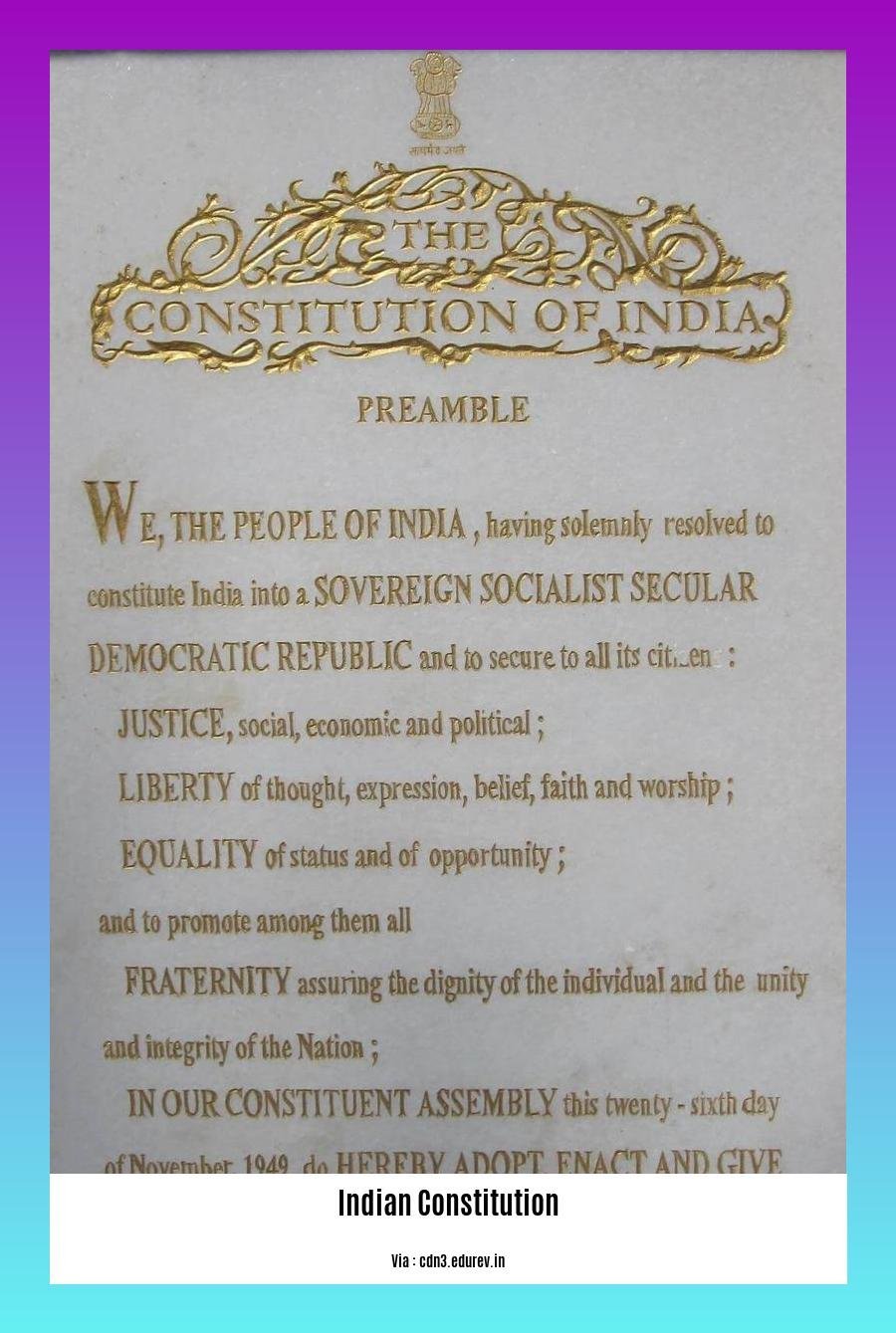Welcome to “Important Facts About the Indian Constitution: A Comprehensive Guide.” In this article, we will delve into the essential details and fascinating aspects of the Indian Constitution. As one of the world’s longest written constitutions, it serves as the bedrock of India’s democracy and governance, encompassing a wide range of constitutional principles, rights, and duties. As we navigate through the depths of this remarkable document, we will explore the fundamental features that shape the functioning of India’s legal framework, providing you with a comprehensive understanding of the Indian Constitution.
Key Takeaways:
- The Indian Constitution is the longest constitution in the world, consisting of a Preamble, 22 parts with 448 articles, 12 schedules, 5 appendices, and 115 amendments.
- The original copies of the Indian Constitution were written in both Hindi and English, with each member of the Constituent Assembly signing two copies.
- The Indian Constitution was handwritten and decorated by artists during the drafting process in December 1946.
- The Indian Constitution upholds principles of equality, fraternity, secularism, and more, and draws inspiration from various other countries.
Important Facts About the Indian Constitution: A Comprehensive Guide

The Indian Constitution is a remarkable document that upholds principles of equality, fraternity, secularism, and much more. It stands as the longest constitution in the world, consisting of a Preamble, 22 parts with 448 articles, 12 schedules, 5 appendices, and 115 amendments. Let’s dive into some fascinating facts about the Indian Constitution that highlight its uniqueness and significance.
Fact #1: The Longest Constitution in the World
The Indian Constitution holds the record for being the longest constitution globally. Its extensive content covers various aspects of governance and citizen’s rights. With its comprehensive approach, it provides a robust framework that guides the functioning of the country’s political and legal systems.
Fact #2: Bilingual and Handwritten
The original copies of the Indian Constitution were written in both Hindi and English. This extraordinary effort aimed at ensuring that both official languages of India have equal importance in the constitutional framework. Interestingly, the entire constitution was handwritten, showcasing the dedication and meticulousness of the framers.
Fact #3: Artistic Ingenuity
During the drafting process of the Indian Constitution, each page was adorned with beautiful artistic designs created by skilled artists. This unique practice aimed to highlight the significance and celebrate the artistic spirit of the document. It added a touch of creativity and visual appeal to the otherwise formal and legal text.
Now that we’ve explored these intriguing facts, let’s take a moment to appreciate the Indian Constitution’s overall significance. It goes beyond being a mere governing document; it is a reflection of the nation’s values, diversity, and aspirations. The Indian Constitution safeguards the rights and freedoms of its citizens and provides a solid foundation for democratic governance.
In conclusion, the Indian Constitution’s length, bilingual nature, and artistic flair make it truly exceptional. With its rich history and deep-rooted principles, the Indian Constitution continues to shape the nation’s journey towards progress, inclusivity, and justice.
[IMPORTANT FACTS ABOUT INDIAN CONSTITUTION]
Sources:
“15 Amazing Facts About The Indian Constitution” by BYJU’S on Knowledge Vine. Available at:
Here are some interesting facts about the constitution of India that you shouldn’t miss! Check out these important facts about the constitution of India and gain a deeper understanding of the foundation of our nation. Just click here to explore.
Have you ever wondered about the lighter side of the Indian constitution? Discover some funny facts about the Indian constitution that will leave you amused! Don’t miss out on these intriguing details – click here to find out more.
The Constitution declares India as a sovereign, socialist, secular, and democratic republic.
The Indian Constitution, often regarded as the longest constitution in the world, is a remarkable document that defines the framework for governance in India. It begins with a powerful and impactful preamble, which declares India as a sovereign, socialist, secular, and democratic republic. In this article, we will delve into the important facts surrounding this declaration and uncover its significance.
Understanding the Preamble
The preamble to the Indian Constitution acts as a guiding light, reflecting the aspirations and values of the nation. It holds tremendous significance as it outlines the purpose and objective of the constitution itself. The preamble is based on the Objectives Resolution, a historic document moved by Jawaharlal Nehru in the Constituent Assembly on 13 December. Despite the Supreme Court initially deeming it as not an integral part of the constitution in the Berubari case, the preamble has nonetheless played a crucial role in shaping India’s constitutional framework.
The Four Pillars of India
Sovereign: The Indian Constitution embodies the idea of sovereignty, meaning that India has independent authority and control over its internal and external affairs. It is not subject to the control or domination of any other state or external power. This provision ensures that India retains its autonomy and can make decisions in the best interest of its citizens.
Socialist: The constitution further declares India as a socialist republic. This term signifies the commitment of the Indian state to promote social justice, equality, and the welfare of its citizens. It emphasizes the need to alleviate poverty, reduce economic inequalities, and create opportunities for all individuals to thrive and prosper.
Secular: India’s secular character is enshrined in the constitution, emphasizing the principle of religious neutrality. This ensures that the state remains impartial and treats all religions and religious communities equally. It protects the freedom of religion and ensures that individuals have the right to profess, practice, and propagate any religion of their choice without discrimination.
Democratic Republic: The Indian Constitution establishes India as a democratic republic, where the power ultimately resides with the people. It upholds the principles of democracy, ensuring that citizens have the right to participate in the governance of the country through elections and other democratic processes. The constitution establishes a democratic system of government with a separation of powers between the legislative, executive, and judicial branches.
Key Takeaways:
- The Indian Constitution, through its preamble, declares India as a sovereign, socialist, secular, and democratic republic.
- Sovereignty ensures independent authority and control over internal and external affairs.
- Socialism emphasizes social justice and equality, striving to uplift all citizens.
- Secularism guarantees religious neutrality and equal treatment for all religions and religious communities.
- Democracy establishes a government of the people, by the people, and for the people.
Sources:
– Wikipedia – Preamble to the Constitution of India
– Wikipedia – Sovereign
The Constitution ensures fundamental rights and duties for Indian citizens.

The Indian Constitution is a comprehensive document that not only establishes the framework for governing the country but also enshrines fundamental rights and duties for its citizens. These rights and duties are crucial for the well-being and progress of Indian society as a whole.
Fundamental Rights: Protecting the Rights of Citizens
One of the key aspects of the Indian Constitution is the provision of fundamental rights. These rights are essential for the development of an individual’s personality and well-being. The Constitution guarantees 11 fundamental rights to its citizens. These include the right to equality, right to freedom of speech and expression, and right to protection of life and personal liberty.
The rights provided by the Constitution serve as a safeguard for citizens against any form of discrimination, injustice, or infringement upon their basic rights. They ensure that every individual in India has the freedom to express themselves, to live with dignity, and to be treated equally under the law.
Fundamental Duties: Upholding Responsibilities towards the Nation
In addition to fundamental rights, the Indian Constitution also lays down certain fundamental duties that every citizen must fulfill. These duties are a significant aspect of the Constitution as they emphasize the responsibilities and obligations of citizens towards the nation.
Some of the fundamental duties outlined in the Constitution include abiding by the Constitution and respecting its ideals and institutions, preserving the rich heritage of India’s composite culture, and defending the country and rendering national service when called upon to do so.
By outlining these fundamental duties, the Constitution instills a sense of responsibility and patriotism in its citizens, compelling them to actively contribute to the well-being and progress of the nation.
Key Takeaways:
- The Indian Constitution guarantees fundamental rights and duties for its citizens.
- Fundamental rights protect the individual’s dignity and ensure equality under the law.
- Fundamental duties emphasize the responsibilities of citizens towards the nation.
- Citizens have a duty to uphold the ideals and institutions of the Constitution and preserve India’s cultural heritage.
- The Constitution creates a framework for democratic governance and safeguards the rights and freedoms of Indian citizens.
To learn more about fundamental rights and duties in the Indian Constitution, you can refer to the following sources:
- Century Law Firm. (n.d.). Fundamental Rights and Duties
- BYJU’S. (n.d.). Fundamental Rights (Article 12-35)
The Constitution Establishes a Federal System with a Parliamentary Form of Government
The Indian Constitution is the backbone of the country’s governance, establishing a federal system with a parliamentary form of government. This unique system combines elements of federalism and parliamentary democracy, providing a framework for the functioning and organization of the government.
Understanding the Federal System
A federal system is one in which power is divided between a central authority and various regional or state governments. In the case of India, the Constitution clearly delineates the powers of the central government (also known as the Union government) and the state governments. This division of power ensures a balance between a strong central government and the autonomy of the states.
Features of the Federal System in India
The federal system established by the Indian Constitution incorporates several key features:
Division of Powers: The Constitution specifies the powers and responsibilities of both the central and state governments. While certain subjects fall under the exclusive jurisdiction of the central government, others are under the purview of the state governments. This division ensures that each government has specific areas of authority.
Independent Judiciary: The Constitution also provides for an independent judiciary that acts as the guardian of the Constitution and ensures that the governments operate within their powers. The judiciary has the authority to interpret the Constitution and settle disputes between the central and state governments.
Bicameral Legislature: India follows a bicameral system of legislature, consisting of two houses – the Lok Sabha (House of the People) and the Rajya Sabha (Council of States). The Lok Sabha represents the people of India through elected members, while the Rajya Sabha represents the states and union territories. This system allows for checks and balances in the lawmaking process.
Dual Government Polity: The federal system in India allows for dual government polity. This means that there are separate governments at both the central and state levels, each with its own executive, legislative, and judicial branches. This arrangement enables efficient governance and ensures that the interests of both the center and the states are represented.
Supremacy of the Constitution: The Indian Constitution is the supreme law of the land, and all laws and government actions must conform to its provisions. This ensures that the government operates within the limits set by the Constitution and protects the rights and freedoms of its citizens.
Understanding the Parliamentary Form of Government
In addition to the federal system, the Indian Constitution establishes a parliamentary form of government. This means that the executive branch of the government is responsible to the legislature, and the head of state is usually a ceremonial figurehead. In India, the President serves as the head of state, while the Prime Minister is the head of government.
Under the parliamentary system, the political party or coalition of parties that holds the majority in the Lok Sabha forms the government. The Prime Minister, who is the leader of the majority party, is then appointed by the President. The Prime Minister, along with the Council of Ministers, exercises executive powers and is accountable to the Parliament.
Key Takeaways:
- The Indian Constitution establishes a federal system with a parliamentary form of government.
- The federal system in India balances power between the central government and state governments, ensuring both autonomy and a strong central authority.
- The key features of the federal system include a clear division of powers, an independent judiciary, a bicameral legislature, a dual government polity, and supremacy of the Constitution.
- The parliamentary form of government in India makes the executive branch accountable to the legislature, with the Prime Minister as the head of government.
- Understanding the constitutional structure of India is essential to grasp the functioning and organization of the government.
Sources:
– Britannica: Constitution – Theories, Features, Practices, & Facts
– National Archives: The Constitution: What Does it Say?
FAQ
Q1: How long is the Indian Constitution?
A1: The Indian Constitution holds the record for being the longest constitution in the world. It consists of a Preamble, 22 parts with 448 articles, 12 schedules, 5 appendices, and 115 amendments.
Q2: In what languages were the original copies of the Indian Constitution written?
A2: The original copies of the Indian Constitution were written in both Hindi and English.
Q3: Was the Indian Constitution handwritten or printed?
A3: Interestingly, the Indian Constitution was handwritten rather than being printed or typed. It was written in Hindi and English.
Q4: What was the significance of artists decorating each page of the Indian Constitution during its drafting process?
A4: During the drafting process of the Indian Constitution, each page was decorated by artists, highlighting the significance and artistic ingenuity of the document.
Q5: What are some important fundamental rights guaranteed by the Indian Constitution?
A5: The Indian Constitution provides for 11 fundamental rights that are guaranteed to the citizens. These rights include the right to equality, right to freedom of speech and expression, and right to protection of life and personal liberty.









